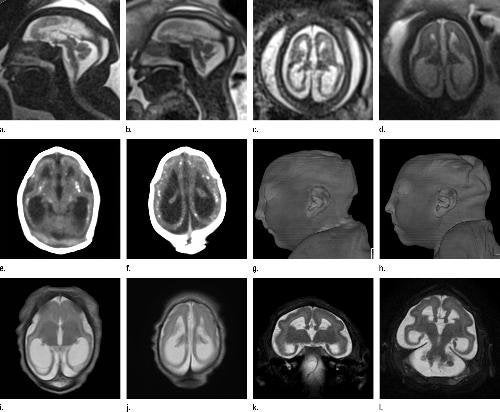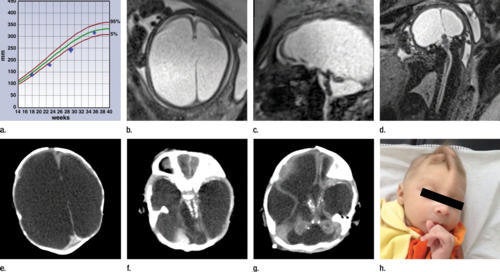
New research that documents the devastating effects of Zika virus in early pregnancy shows just how destructive the disease can be to a growing fetus.
The new study, which was published in the journal Radiology, contains the largest collection to date of brain scans in fetuses and newborns with Zika virus. It details the different kinds of brain abnormalities that can occur in a developing fetus, causing the birth defect microcephaly.
The scans emphasize the importance of regular imaging over the course of a pregnancy, as a fetus that appears normal during early gestation may have signs of the infection during a later scan. The images also show that just because an infant may be born with a normal-sized head, rather than the abnormally small head typical of microcephaly, it doesn’t mean their brain has escaped damage from the infection.
Most doctors will likely never see, let alone treat, a pregnant woman with Zika. But as the number of pregnant women with Zika virus continues to rise in the U.S. and its territories, and as the virus continues to spread in Florida, these images are an invaluable window into the slow-motion destruction that happens inside a fetus’ brain and will affect the child for the rest of his or her life.
Microcephaly is caused by several distinct brain abnormalities
The study was conducted by Dr. Fernanda Tovar-Moll, vice president of the D’Or Institute for Research and Education and professor at Brazil’s Federal University of Rio de Janeiro. She recruited 17 fetuses or newborns of women who had documented Zika virus infection, as well as 28 fetuses or newborns in women with presumed Zika virus, and scanned them over the course of the pregnancies with fetal MRIs and ultrasound scans and afterward with brain CT and MRI scans.
Tovar-Moll found that the brain abnormalities in both groups of participants were very similar in that nearly all participants showed signs of ventriculomegaly, which is a condition in which the ventricles of the brain — four interconnected, fluid-filled spaces that cushion the brain — swell and become larger than normal. In three fetuses who appeared to have a normal head circumference, this was only because their ventricles had enlarged so much that the extra volume was making up for the loss in brain matter.
In the set of photos below, fetal MRI scans taken at 36 weeks pregnancy (figures b-d) show extreme, asymmetric ventriculomegaly with a sloping forehead and a thin brainstem and spinal cord. This leads to the wrinkled, folded look of a Zika-affected newborn’s head, as the swelling from the ventriculomegaly causes the skull to enlarge before decompressing and collapsing on itself.

Figures E-F are CT images from one day after birth, and show that the severe asymmetric ventriculomegaly has persisted, along with dense calcifications throughout the brain that can disrupt the organ’s normal processes.
Figure G was a CT image obtained six weeks after birth, and image H is a photo of the newborn’s face with skin folds and an asymmetrical skull.
Other similarities between the groups in the study included abnormalities in the corpus callosum, a broad band of nerve fibers that connect the two hemispheres of the brain and allow the two sides to communicate with each other. Almost all of the newborns had calcium deposits inside the brain, and all of them had reduced brain matter.
Head size can fluctuate throughout pregnancy
Co-author Dr. Deborah Levine, the director of the Obstetric and Gynecologic Ultrasound at Beth Israel Deaconess Medical Center and senior deputy editor of the journal Radiology, which published this study, says that the research mainly focuses on Zika virus infections that happen in the first trimester. This is a time many agree is the most perilous for a developing fetus, which is why the cases detailed in the report are among the most severe examples of Zika virus-caused brain damage.
But because of this, the study doesn’t provide any insight on what mild Zika virus infection would look like, or what might result from an infection that occurs in the second or third trimesters.
Levine emphasized that just because three fetuses appeared to have normal head circumferences that hid serious brain damage, the same brain damage may not necessarily be the case for other babies who appear “normal” when born to mothers who experienced a Zika infection. It’s still an open question what effects prenatal Zika virus infection will have, if any, on babies that have a normal head circumference.
“If a baby’s born and looks normal, we’re going to hope that baby is normal,” she said. However, Levine clarified that this paper doesn’t answer this question, as researchers won’t know how the babies will develop until much later.
The study also underscored the importance of serial ultrasounds throughout the course of the pregnancy, as abnormalities may appear early on and then seem to disappear, or abnormalities may not be apparent until very late in the pregnancy. The U.S. Centers for Disease Control and Prevention recommends multiple ultrasounds as part of prenatal care for women infected with Zika virus.
“We have some fetuses that had been followed over time, where the head size was initially normal, and then it started dropping off the growth curve,” Levine explained. “And then we had a case where the head size was initially small and then became normal, and it ended up that this was not reassuring because the reason the head size was normal was that the ventricles were so large.”
In the photos below, the ultrasound images obtained at 30 weeks of pregnancy (figures a-h) show an abnormally small head circumference, calcifications, a small corpus callosum, and a three-dimensional image that shows a sloping forehead. Figures i-k are fetal MRI scans obtained at 29 weeks of pregnancy, and figure l shows the baby after birth.

Zika virus can destroy more than the brain
In addition to brain abnormalities, some babies in this study also showed signs of severe arthrogryposis, joint malformations that prevent normal flexion and extension. Some scientists are proposing that arthrogryposis be added to the list of conditions that are encompassed in the term “congenital Zika virus syndrome,” a disease that describes all the birth defects caused by exposure to Zika virus in the womb.
The photos below depict a baby whose joint contractures were detected in ultrasound at 17 weeks, though the baby’s head circumference remained in the normal range until 21 weeks. Figure A shows calcifications and ventriculomegaly. Figures B and C are reconstructions of what the baby’s soft tissue and bone structure would look like. Figures D and E are post-mortem CT images that confirm ventriculomegaly, calcifications, and other abnormalities. Figure F is a photo of the newborn, who died less than 48 hours after birth.

While the research findings are targeted more toward the medical community that may one day treat a baby exposed to Zika virus in the womb, the images and descriptions of the severe damage caused by the disease emphasize just how crucial it is for women living in areas affected by Zika virus to take steps to prevent mosquito bites or sexual transmission of the virus.
If pregnant women do suspect that they’ve been exposed to Zika virus, either because of travel to an affected area or sex with someone who has traveled, they should go to their doctor right away to request a test, and follow up with regular prenatal care that will monitor the fetus’ growth throughout pregnancy.
